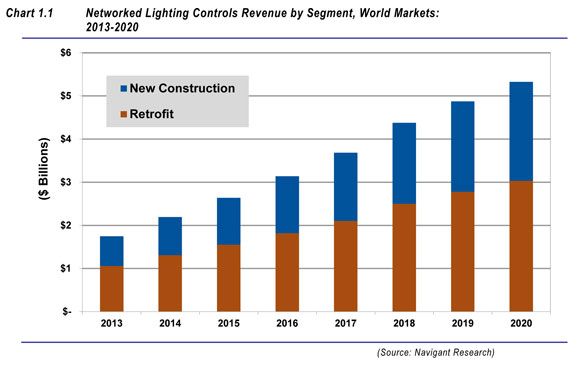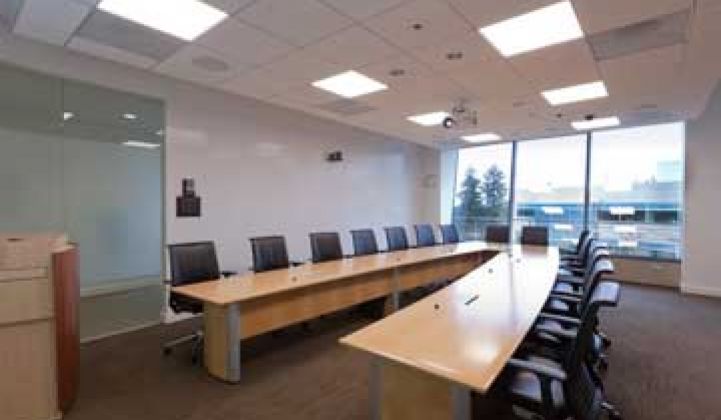The lighting controls market is not just poised for takeoff; it is already in the air.
Commercial networked lighting systems will grow from $1.7 billion in 2012 to more than $5.3 billion by 2020, according to a new report by Navigant Research.
As light-emitting diode (LED) prices drop, controls increasingly make sense because of the inherently controllable nature of solid-state lights. But it is more than just dimming lights that’s driving the networked lighting systems.
Sensors that are key to dynamic, networked lighting can also be used for occupancy applications. In the U.S., Navigant notes that the 2010 version of the American Society of Heating, Refrigerating and Air-Conditioning Engineers (ASHRAE) 90.1 standard will soon become the national standard, and it will require occupancy and photo sensors in many spaces. In Europe, new public buildings have to be built net-zero and China’s latest five-year plan has strong energy efficiency targets that should drive lighting controls adoption.
Navigant sees much of the growth from new construction coming from the Asia-Pacific region, although retrofits will still make up more than half of the market.

In buildings, the advantages are also as much about occupancy as lighting. Last year, lighting network startup Redwood Systems (which was acquired by CommScope last month) opened up its platform to its customers to develop novel applications.
The first apps to be developed were less about lighting and more about occupancy, from understanding how conference rooms were being used to integrating HVAC data with occupancy data to set temperatures more accurately.
“We believe occupancy is an untapped area that has huge potential benefits for corporations,” said Sam Klepper, who was chief marketing officer of Redwood Systems at the time the platform was opened. “We think that’s the biggest, most immediate opportunity.”
Although companies are looking for lighting networks to address more than just lighting concerns, Navigant forecasts that revenue from occupancy sensors and photosensors will grow at a lower overall rate than networked lighting controls equipment. Navigant sees dimming ballast and drivers growing at a 31 percent compound annual growth rate from 2013 to 2020, nearly double the rate at which the occupancy sensor market is expected to grow.
“Building owners and managers, who are accustomed to the idea of centrally monitoring and managing their heating, ventilation, and air conditioning systems, are beginning to expect the same level of control from lighting systems,” Jesse Foote, research analyst with Navigant Research, said in a statement.
There market is chock-full of incumbents and newcomers. Enlighted raised $20 million for networked smart lighting nodes earlier this year. Last year, Adura landed $8.5 million for its networked lighting platform. But startups aren’t necessarily going it alone. Daintree Networks partnered with Sylvania and Philips last year to push out its technology through the established installation networks of the big guys. Adura has partnered with the EnOcean Alliance.
Many cities are taking the lead on switching out lighting, particularly out in the streets. The prices on LED street lights continue to come down, Cree recently launched a $99 LED street light, and cash-strapped cities are happily making the switch.
LED street lights offer more than just energy savings and multi-year warranties, however. Networked lighting can offer additional public safety measures and dim or brighten based on certain conditions.
The advantages of networked lighting are only just being realized. As applications proliferate, both in commercial buildings and everywhere that light bulbs are screwed in, the $5 billion market could just be the beginning.



